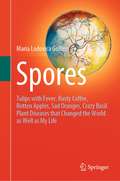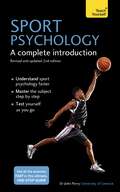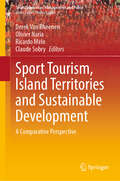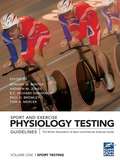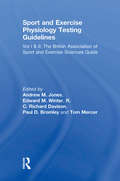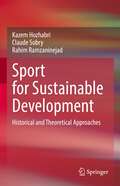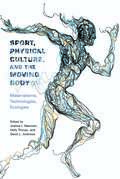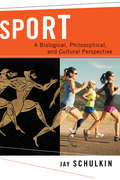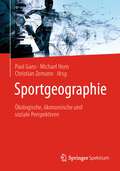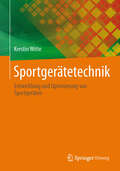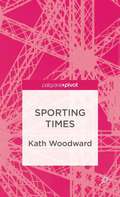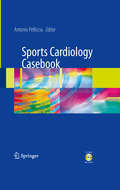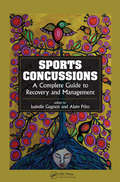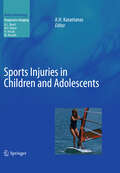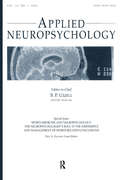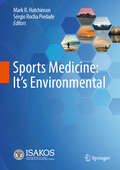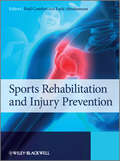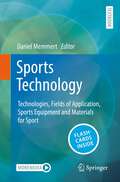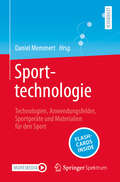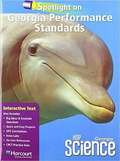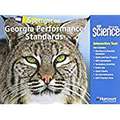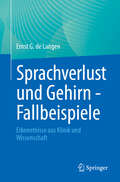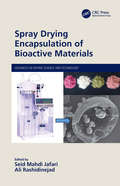- Table View
- List View
Spores: Tulips with Fever, Rusty Coffee, Rotten Apples, Sad Oranges, Crazy Basil. Plant Diseases that Changed the World as Well as My Life
by Maria Lodovica GullinoThis book aims to describe, though in a quite light way, the social role of plant diseases, letting the reader know the topical importance of plant pathology, as well as the role of plant pathologists in our society. Plant diseases caused, in the past, significant economic losses, deaths, famine, wars, and migration. Some of them marked the history of entire countries. One example among many: the potato late blight in Ireland in 1845. Today plant diseases are still the cause of deaths, often silent, in developing countries, and relevant economic losses in the industrialized ones. This book, written with much passion, neither wants to be a plant pathology text. On the contrary, it wants to describe, in simple words, often enriched by the author's personal experience, various plant diseases that, in different times and countries, did cause severe losses and damages. Besides the so-called “historical plant diseases”, in the process of writing this book, she wanted to describe also some diseases that, though not causing famine or billions of losses, because of their peculiarity, might be of interest for the readers. Thus, this book has not been conceived and written for experts, but for a broader audience, of different ages, willing to learn more about plant health and to understand the reasons why so many people in the past and nowadays choose to be plant pathologists. This is because plants produce most of the food that we consume, that we expect to be healthy and safe, and because plants make the world beautiful. The title “Spores” is evocative of the reproduction mean of fungi. Spores are small, light structures, often moving fast. The chapters of this book are short and concise. Just like spores!
Sport Psychology: A complete introduction
by John PerryThink about your favourite sport. Now ask yourself how much of success in that sport is down to physical skills and how much is down to mental skills?We all know that physical skills are vital for performance and understand about training them. We know that psychology is important too, but what people actually do to understand and train in it is less well known. Sport Psychology: A complete introduction gives you the answers, explaining everything you need to know in one place.Structured in two parts, theory and application, part one defines the idea of personality and covers essential psychological traits, including mental toughness, confidence, motivation, stress and character. Part two covers topics such as assessment, skills training, coping techniques, building concentration and working with coaches and teams. You will also find substantial coverage of measurement questionnaires, skills and routes to practice. As well as learning about how the mind works and how that has an impact on sporting performance, you will discover what sport psychologists actually do to improve a performer's psychological skills and mindset. Sport psychology used to be simply about performance. Now, the role of the sport psychologist is more holistic and includes athlete wellbeing, working with coaches and support teams, and operating at a more organizational level.Whether you are a student, interested in sport and sport performance as a professional practice, or involved in sport at any level, Sport Psychology: A complete introduction is your go-to guide.
Sport Psychology: A complete introduction
by John PerryThink about your favourite sport. Now ask yourself how much of success in that sport is down to physical skills and how much is down to mental skills?We all know that physical skills are vital for performance and understand about training them. We know that psychology is important too, but what people actually do to understand and train in it is less well known. Sport Psychology: A complete introduction gives you the answers, explaining everything you need to know in one place.Structured in two parts, theory and application, part one defines the idea of personality and covers essential psychological traits, including mental toughness, confidence, motivation, stress and character. Part two covers topics such as assessment, skills training, coping techniques, building concentration and working with coaches and teams. You will also find substantial coverage of measurement questionnaires, skills and routes to practice. As well as learning about how the mind works and how that has an impact on sporting performance, you will discover what sport psychologists actually do to improve a performer's psychological skills and mindset. Sport psychology used to be simply about performance. Now, the role of the sport psychologist is more holistic and includes athlete wellbeing, working with coaches and support teams, and operating at a more organizational level.Whether you are a student, interested in sport and sport performance as a professional practice, or involved in sport at any level, Sport Psychology: A complete introduction is your go-to guide.
Sport Tourism, Island Territories and Sustainable Development: A Comparative Perspective (Sports Economics, Management and Policy #24)
by Ricardo Melo Claude Sobry Derek Van Rheenen Olivier NariaThis edited volume discusses the role of sport tourism in local sustainable development in small island territories. Using an international, comparative study, this volume explores the contributions of sport tourism to sustainable development in island settings. Written by 25 research teams across ten seas, oceans, and island archipelagos, chapters present comparative findings with the view of assisting stakeholders and decision-makers in collaboratively and responsibly developing island territories in accordance with specific sustainable development goals. Presenting a refined comparative methodology at the intersection of sport tourism and sustainable development, this book is geared towards academic researchers and students interested in sport tourism, sports economics, management and sustainable development, as well as professionals.
Sport and Exercise Physiology Testing Guidelines: The British Association of Sport and Exercise Sciences Guide
by Andrew M. Jones Edward M. Winter R.C. Richard Davison Paul D. Bromley Tom H. MercerSport and exercise physiologists are called upon to carry out physiological assessments that have proven validity and reliability, both in sport-specific and health-related contexts. A wide variety of test protocols have been developed and refined. This book is a comprehensive guide to these protocols and to the key issues relating to physiological testing. Volume I covers sport-specific testing, and Volume II covers clinical and exercise specific testing. With contributions from leading specialist sport, exercise and clincial physiologists, and covering a wide range of mainstream sports, special populations, and ethical, practical and methodological issues, these volumes represent an essential resource for sport-specific and clinical exercise testing in both research and applied settings. Visit the companion website at www.routledgesport.com/bases
Sport and Exercise Physiology Testing Guidelines: The British Association of Sport and Exercise Sciences Guide
by Andrew M. Jones Edward M. Winter R.C. Richard Davison Paul D. Bromley Tom MercerSport and exercise physiologists are called upon to carry out physiological assessments that have proven validity and reliability, both in sport-specific and health-related contexts. A wide variety of test protocols have been developed and refined. This book is a comprehensive guide to these protocols and to the key issues relating to physiological testing. Volume I will cover sport-specific testing, and Volume II clinical and exercise testing. With contributions from many leading specialist physiologists, and covering a wide range of mainstream sports, special populations, and ethical, practical and methodological issues, these volumes represent an essential resource for sport-specific and clinical exercise testing in both research and applied settings. Visit the companion website at: www.routledgesport.com/bases.
Sport for Sustainable Development: Historical and Theoretical Approaches
by Claude Sobry Kazem Hozhabri Rahim RamzaninejadThis book looks at the potential of sport to contribute to wide-ranging development outcomes, which have been recognized across international policy declarations, most significantly in the 2030 UN Agenda for Sustainable Development. It provides a theoretical approach to sport and development. It begins by addressing the basic concepts of sport development and sustainability and then discusses the potential contribution of sport to five prioritized SDGs (SDGs 3, 4, 5, 8 and 16) and the environment as one of the sustainable development pillars that may contribute to SDGs 6, 7, 11, 12, 13, 14 and 15. This academic resource provides a macro view to students and researchers of sports sciences to know more about the fundamental concepts of sustainable development goals, and to enhance their knowledge about sport as a conduit that can help achieve wider development outcomes rather than being an end in itself. This book is of interest to students and researchers of sports studies, from sociology to management, and researchers and policy makers interested in sport and sustainable development.
Sport, Physical Culture, and the Moving Body: Materialisms, Technologies, Ecologies (Critical Issues in Sport and Society)
by David Andrews Samantha Frost Simone Fullagar Mary Louise Adams Samantha King Pirkko Markula Michael D. Giardina Matthew G. Hawzen Oliver Rick Jacob J. Bustad Richard Pringle Mary G. McDonald Kiri Baxter Douglas Booth Kyle S Bunds Mariana Clark Simon C Darnell Jennifer Sterling Christopher McLeod Shannon Leigh Jette Katelyn Esmonde Carolyn Pluim Gavin WeedonThe moving body—pervasively occupied by fitness activities, intense training and dieting regimes, recreational practices, and high-profile sporting mega-events—holds a vital function in contemporary society. As the body moves—as it performs, sweats, runs, and jumps—it sets in motion an intricate web of scientific rationalities, spatial arrangements, corporate imperatives, and identity politics (i.e. politics of gender, race, social class, etc.). It represents vitality in its productive and physiological capacities, it drives a complex economy of experiences and products, and it is a meaningful site of cultural identities and politics. Contributors to Sport, Physical Culture, and the Moving Body work from a simple premise: as it moves, the material body matters. Adding to the burgeoning fields of sport studies and body studies, the works featured here draw upon the traditions of feminist theory, posthumanism, actor network theory, and new materialism to reposition the physical, moving body as crucial to the cultural, political, environmental, and economic systems that it constitutes and within which is constituted. Once assembled, the book presents a study of bodies in motion—made to move in contexts where technique, performance, speed, strength, and vitality not only define the conduct therein, but provide the very reason for the body’s being within those economies and environments. In so doing, the contributors look to how the body moving for and about rational systems of science, medicine, markets, and geopolity shapes the social and material world in important and unexpected ways. In Sport, Physical Culture, and the Moving Body, contributors explore the extent to which the body, when moving about both ostensibly active body spaces (i.e., the gymnasium, the ball field, exercise laboratory, the track or running trail, the beach, or the sport stadium) and those places less often connected to physical activity (i.e. the home, the street, the classroom, the automobile), is bounded to technologies of life and living; and to the political arrangements that seek to capitalize upon such frames of biological vitality. To do so, the authors problematize the rise of active body science (i.e. kinesiology, sport and exercise sciences, performance biotechnology) and the effects these scientific interventions have on embodied, lived experience. Contributors to Sport, Physical Culture, and the Moving Body will be engaging a range of new and emerging theoretical perspectives, including new materialist, political ecology, developmental systems theory, and new material feminist approaches, to examine the actors and assemblages of movement-based material, political, and economic production. In so doing, contributors will vividly and powerfully illustrate the extent to which a focus on the fleshed body and its material conditions can bring forth new insights or ontological and epistemological innovation to the sociology of sport and physical activity. They will also explore the agency of the body as and amongst things. Such a performative materialist approach explicates how complex assemblages of sport and physical activity—bringing into association everything from muscle fibers and dietary proteins to stadium concrete or regional aquifers—are not only meaningful, but ecological. By focusing on the confluence of agentive materialities, disciplinary technologies, vibrant assemblages, speculative realities, and vital performativities, Sport, Physical Culture, and the Moving Body promises to offer a groundbreaking departure from representationalist tendencies and orthodoxies brought about by the cultural turn in sport and physical cultural studies. It brings the moving body and its physics back into focus: recentering moving flesh and bones as locus of social order, environmental change, and the global political economy.
Sport: A Biological, Philosophical, and Cultural Perspective
by Jay SchulkinSports are as varied as the people who play them. We run, jump, and swim. We kick, hit, and shoot balls. We ride sleds in the snow and surf in the sea. From the Olympians of ancient Greece to today's professional athletes, from adult pickup soccer games to children's gymnastics classes, people at all levels of ability at all times and in all places have engaged in sport. What drives this phenomenon?In Sport, the neuroscientist Jay Schulkin argues that biology and culture do more than coexist when we play sports—they blend together seamlessly, propelling each other toward greater physical and intellectual achievement. To support this claim, Schulkin discusses history, literature, and art—and engages philosophical inquiry and recent behavioral research. He connects sport's basic neural requirements, including spatial and temporal awareness, inference, memory, agency, direction, competitive spirit, and endurance, to the demands of other human activities. He affirms sport's natural role as a creative evolutionary catalyst, turning the external play of sports inward and bringing insight to the diversion that defines our species. Sport, we learn, is a fundamental part of human life.
Sportgeographie: Ökologische, ökonomische und soziale Perspektiven
by Paul Gans Michael Horn Christian ZemannVom Lauf im Park bis zu Olympischen Spielen – Sport hat viele Facetten und die Wirkungen auf Umwelt, Wirtschaft und Gesellschaft sind immens. Sport braucht dabei immer Räume: Stadien, Sportplätze und Schwimmhallen, Berge und Wälder, Parks, Straßen oder Industriebrachen. Individualisierung und Lifestyle differenzieren den Sport mit neuen Anforderungen an die Nutzung des Raumes.Ökologisch wirkt Sport im Spannungsfeld Natursport und Naturschutz oder wenn Großveranstaltungen neue Infrastrukturen benötigen und zehntausende Menschen anziehen. Ökonomische und soziale Effekte können erheblich sein, sind oft aber nur von kurzer Dauer. Dies führt zur Frage der Nachhaltigkeit. Was bewirkt Skibetrieb in Zeiten des Klimawandels? Was kosten sportliche Großereignisse, welche Effekte entstehen auf Einkommen und Arbeitsmarkt? Was trägt Sport zu Integration, Empowerment, Image und Identität bei? Und wie können Kommunen und Regionen dies in die Planung von Sportstätten und in die Sport- und Stadtentwicklung integrieren? Das erste Buch, das Sport und Geographie aus Perspektiven der Nachhaltigkeit umfassend vereint, behandelt Wirkungen und deren Ursachen systematisch, bietet Definitionen wichtiger Konzepte und bezieht Breitensport, Trendsport und Natursport ebenso ein wie Spitzensport. Basierend auf langjähriger Forschung beleuchten die Autorinnen und Autoren aus unterschiedlichen Disziplinen die Entwicklungen sportlicher Aktivitäten und ihre Raumansprüche. Als Lehrbuch bietet dieser Band einen linearen Einstieg und Überblick. Im Sinne eines Sammelbands kann jedes Kapitel für sich gelesen werden. Die Erkenntnisse sind gleichermaßen nützlich für Forschende und Studierende der Fächer Geographie, Sportwissenschaft, Sozialwissenschaft und Wirtschaftswissenschaften sowie der Raum-, Regional- und Stadtplanung.
Sportgerätetechnik
by Kerstin WitteDas Buch schlägt Lösungskonzepte zur Entwicklung und Optimierung von Sportgeräten und Sportausrüstungen vor. Dabei werden die besonderen physikalischen und biomechanischen Aspekte dieser Produkte berücksichtigt. Auch wird auf die unterschiedlichen Benutzergruppen eingegangen. Durch zahlreiche praktische Beispiele und die Erläuterung des methodischen Vorgehens erhält der Leser Anregungen für neue Produktentwicklungen als auch deren Evaluation im Bereich der Sportartikel. So wird es ihm möglich sein, Lösungen für sein konkretes Problem zu finden.
Sporting Times
by Kath WoodwardWritten against the backdrop of the 2012 London Olympics, this book examines the idea of 'time' in sport, using time as a conceptual lens to explore movement, bodies, sports reporting, memory, disability, technology and the role of the past and the future in sport.
Sports Cardiology Casebook
by Antonio PellicciaComparatively little is known about the risk of sudden death associated with exercise in young competitive athletes, and whether the benefits of sports activity outweigh the hazards of exercise-related fatal events is a clinical dilemma. This is only a small part of the story, however, as there are considerable effects of exercise whether it be at a competitive level or on a 'leisure' level on patients of all ages. This in itself is of massive importance to the cardiac patient population as exercise is a key component of effective recovery and recommended as central in the prevention of much cardiac disease.
Sports Concussions: A Complete Guide to Recovery and Management
by Isabelle Gagnon Alain PtitoSport-related concussions have become an increasingly important topic as evidenced by recent media attention. Due in large part to the complex nature of concussive injuries, there is great discrepancy in the effect these injuries have on individual functioning and the type and nature of services that best facilitate recovery. This book is intended as a complete reference guide dealing with sports-related concussions.
Sports Injuries in Children and Adolescents
by Apostolos H. KarantanasThe incidence of acute and overuse sports injuries in children and adolescents are increasing. Radiologists need to be familiar with the advantages and limitations of the various imaging modalities used to evaluate the injured young athlete. This book, written by leading experts from Europe and the United States, covers a wide spectrum of sports injuries seen in children and adolescents. The first part comprises a series of introductory chapters on topics such as the clinician's viewpoint, normal anatomy and variants, the imaging of articular cartilage, and the current role of ultrasonography. In subsequent chapters, each important site of injury is considered individually with the aid of informative images. The final part of the book resembles an atlas and presents the most commonly encountered injuries in the popular sports of football, skiing, water sports, tennis, and gymnastics. Throughout, particular attention is paid to the most recent advances in knowledge and imaging.
Sports Medicine and Neuropsychology: the Neuropsychologist's Role in the Assessment and Management of Sports-related Concussions:a Special Issue of applied Neuropsychology
by B. P. UzzellThe focus of Sports Medicine and Neuropsychology is the question of what role the neuropsychologist should have in the diagnosis, treatment, and management of sports-related concussions. The goal of this special issue is to examine the most current issues facing this growing and dynamic field of neuropsychology. The first article is dedicated to reviewing current issues in the neuropsychological assessment of concussions in sports-related events. The next paper examines data on over six million practice-and-game-exposures among athletes participating in the NCAA's Injury Surveillance System. Two contributions examine the empirical role that neuropsychologists can have in the area of concussion research. The final two papers review the advantages and limitations on computer-based assessment of sports-related concussions and discuss neuropsychology's role in return-to-play decisions following them.
Sports Medicine: It's Environmental
by Sérgio Rocha Piedade Mark R. HutchinsonThis book serves as an essential quick reference for team physicians, focusing on the risks associated with athletic participation in various environments. It covers a wide range of environmental challenges, including heat, cold, UV exposure, bad weather such as lightning and hurricanes, mountainous and high-altitude conditions, wet and isolated environments, crowded mass sporting events, dangerous situations, contagious diseases, indoor settings, and polluted air and water quality. The book follows a consistent structure to facilitate easy cross-referencing, including clinical pearls for identifying environment-related injuries or diseases, recommended initial treatment responses, and guidelines for extraction from pathological environments. The reader will find each chapter featuring learning objectives and key reading references. This practical manual offers the reader an essential tool to navigate the complexities of environmental medicine in sports, ensuring the health and safety of athletes in any setting.
Sports Rehabilitation and Injury Prevention
by Paul Comfort Earle AbrahamsonThis text provides a comprehensive, practical, evidence-based guide to the field. It covers each stage of the rehabilitation process from initial assessment, diagnosis and treatment, to return to pre-injury fitness and injury prevention. Presenting a holistic approach, this text also addresses the nutritional and psychological aspects of the rehabilitation process for the amateur sports enthusiast as well as elite athletes.Divided into five parts, Parts I, II and III cover screening and assessment, the pathophysiology of sports injuries and healing and the various stages of training during the rehabilitation process. Part IV covers effective clinical decision making, and Part V covers joint specific injuries and pathologies in the shoulder, elbow wrist and hand, groin and knee.Key features:Comprehensive. Covers the complete process from diagnosis and treatment to rehabilitation and prevention of injuries.Practical and relevant. Explores numerous real world case studies and sample rehabilitation programmes to show how to apply the theory in practice.Cutting Edge. Presents the latest research findings in each area to provide an authoritative guide to the field.
Sports Technology: Technologies, Fields of Application, Sports Equipment and Materials for Sport
by Daniel MemmertSports technological tools and innovations are gaining increasing significance in amateur, elite, and health-related sports. Sports technology refers to the application of scientific and technical principles, along with innovative technologies, to enhance athletic performance, increase safety, and consequently optimize the overall sporting experience. This involves the design, development, and utilization of equipment, devices, systems, and software specifically tailored for athletic purposes.This textbook aims to encompass the broad diversity of sports technology by featuring contributions from over 30 authors within their respective specialized fields, summarizing the latest insights concisely. The work is structured into five main sections: Data Acquisition Systems, Sports Equipment and Materials, Diagnostics, Evaluation and Communication, and Selected Fields of Application. Students with a connection to sports science gain a comprehensive understanding of sports technology supported by a carefully designed concept that facilitates easy delivery of learning content. Digital learning cards (SN Flashcards) reinforce the learning effect and ensure optimal exam preparation. For advanced learners, in-depth discussions on topics such as tracking data, digital training assistants, sports floor characteristics, virtual reality in sports, smartphone apps, and diagnostic tools offer additional value.
Sporttechnologie: Technologien, Anwendungsfelder, Sportgeräte und Materialien für den Sport
by Daniel MemmertSporttechnologische Tools und Innovationen erhalten im Breiten-, Leistungs- und Gesundheitssport eine immer größere Bedeutung. Sporttechnologie bezieht sich auf die Anwendung wissenschaftlicher und technischer Prinzipien sowie innovativer Technologien, um sportliche Leistung zu verbessern, die Sicherheit zu erhöhen und somit das gesamte Sporterlebnis zu optimieren. Dabei geht es um das Design, die Entwicklung sowie den Einsatz von Ausrüstung, Geräten, Systemen und Software, speziell für sportliche Zwecke.Dieses Lehrbuch möchte der breiten Vielfalt der Sporttechnologie gerecht werden, indem mehr als 30 Autorinnen und Autoren aus ihrem Spezialgebiet berichten und neuste Erkenntnisse prägnant zusammenfassen. Das Werk gliedert sich in fünf Hauptabschnitte: Daten-Erfassungssysteme, Sportgeräte und Materialien, Diagnostik, Evaluation und Kommunikation sowie Ausgewählte Anwendungsfelder. Studierende mit Bezug zur Sportwissenschaft erhalten einen umfassenden Einblick in die Sporttechnologie, unterstützt durch ein didaktisch ausgefeiltes Konzept, das eine einfache Vermittlung der Lerninhalte ermöglicht. Digitale Lernkarten (SN Flashcards) untermauern den Lerneffekt und gewährleisten eine optimale Prüfungsvorbereitung. Für Fortgeschrittene bietet die vertiefende Diskussion von Themen wie Tracking Daten, digitalen Trainingsassistenten, Sportbodeneigenschaften, virtuelle Realität im Sport, Smartphone Apps und Diagnostik-Tools einen zusätzlichen Mehrwert.
Spotlight on GPS Georgia Science Gr. 2
by Harcourt School Publishers StaffSpotlight on GPS Georgia Science Gr. 2,is a science workbook that is focused on the interaction between weather, plants, animals and people.
Spotlight on Georgia Performance Standards: HSP Science
by HarcourtPeople study plant and animal fossils to learn about plants and animals that lived long ago. Some plants and animals no longer live on Earth. We know about them because of fossils.
Spouted and Spout-Fluid Beds
by John R. Grace Norman EpsteinSince the pioneering text by Mathur and Epstein over 35 years ago, much of the work on this subject has been extended or superseded, producing an enormous body of scattered literature. This edited volume unifies the subject, pulling material together and underpinning it with fundamental theory to produce the only complete, up-to-date reference on all major areas of spouted bed research and practice. With contributions from internationally renowned research groups, this book guides the reader through new developments, insights and models. The hydrodynamic and reactor models of spouted and spout-fluid beds are examined, as well as such topics as particle segregation, heat and mass transfer, mixing and scale-up. Later chapters focus on drying, particle-coating and energy-related applications based on spouted and spout-fluid beds. This is a valuable resource for chemical and mechanical engineers in research and industry.
Sprachverlust und Gehirn - Fallbeispiele: Erkenntnisse aus Klinik und Wissenschaft
by Ernst G. de LangenEin Lesebuch für alle Therapierende in den Bereichen Sprach-, Sprech- und Stimmtherapie sowie Logopädie, Neurologie und Neuropsychologie. Durch die authentische Beschreibung lernt der Lesende die Vielzahl an Syndromen jenseits der "klassischen" Störungsbilder aus dem Bereich der neurogenen Kommunikationsstörungen kennen und erkennen. Fallstudien und Fallbeispiele beschreiben eine große Vielfalt von erworbenen Störungen in den Bereichen Sprache, Schriftsprache, Artikulation und Phonation, deren Pathogenese erklärt und eine Beziehung zur funktionellen Neuroanatomie hergestellt wird.
Spray Drying Encapsulation of Bioactive Materials (Advances in Drying Science and Technology)
by Seid Mahdi Jafari Ali RashidinejadEncapsulation of bioactives is a fast-growing approach in the food and pharmaceutical industry. Spray Drying Encapsulation of Bioactive Materials serves as a source of information to offer specialized and in-depth knowledge on the most well-known and used encapsulation technology (i.e., spray drying) and corresponding advances. It describes the efficacy of spray drying in terms of its advantages and challenges for encapsulation of bioactive ingredients. Discusses the potential of this technique to pave the way toward cost-effective, industrially relevant, reproducible, and scalable processes that are critical to the development of delivery systems for bioactive incorporation into innovative functional food products and pharmaceuticals Presents the latest research outcomes related to spray drying technology and the encapsulation of various bioactive materials Covers advances in spray drying technology that may result in a more efficient encapsulation of bioactive ingredients Includes computational fluid dynamics, advanced drying processes, as well as the morphology of the dried particles, drying kinetics analyzers, process controllers and adaptive feedback systems, inline powder analysis technologies, and cleaning-in-place equipment Aimed at food manufacturers, pharmacists, and chemical engineers, this work is of interest to anyone engaged in encapsulation of bioactive ingredients for both nutraceutical and pharmaceutical applications.
